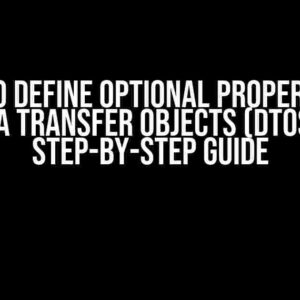Welcome to the world of coding conundrums, where the most frustrating phrase you’ll ever utter is: “I need help getting ConfirmUse bound to CounterView, CounterWView, and SheetView.” Fear not, dear developer, for you’ve stumbled upon the most comprehensive guide to solving this very problem. Buckle up, because we’re about to dive into the world of ViewModels, data binding, and the mystical realm of ConfirmUse.
- Understanding the Players: ConfirmUse, CounterView, CounterWView, and SheetView
- Step 1: Preparing the ViewModel
- Step 2: Binding ConfirmUse to CounterView
- Step 3: Binding ConfirmUse to CounterWView
- Step 4: Binding ConfirmUse to SheetView
- Conclusion: Binding ConfirmUse to CounterView, CounterWView, and SheetView
Understanding the Players: ConfirmUse, CounterView, CounterWView, and SheetView
Before we begin, it’s essential to understand the cast of characters involved in this binding drama.:
- ConfirmUse: A function that enables or disables a control based on a specific condition. Think of it as the gatekeeper of data validation.
- CounterView: A View responsible for displaying a counter or a numeric value. It’s the perfect candidate for binding with ConfirmUse.
- CounterWView: A variation of CounterView, possibly with an additional twist (e.g., displaying a warning or error message).
- SheetView: A View that displays data in a tabular format, often with multiple columns and rows. It’s the ultimate binding challenge.
Step 1: Preparing the ViewModel
To bind ConfirmUse to our Views, we need a robust ViewModel that will serve as the data-binding bridge. Create a new class and add the necessary properties:
public class MyViewModel {
public bool IsConfirmed { get; set; }
public int CounterValue { get; set; }
public ObservableCollection<DataRow> SheetData { get; set; }
public ICommand ConfirmUseCommand { get; set; }
public MyViewModel() {
ConfirmUseCommand = new RelayCommand(ConfirmUse);
}
private void ConfirmUse() {
// Your custom logic to validate and enable/disable the control
}
}
Step 2: Binding ConfirmUse to CounterView
Now that our ViewModel is ready, let’s bind ConfirmUse to CounterView:
<UserControl x:Class="MyCounterView"
xmlns="http://schemas.microsoft.com/winfx/2006/xaml/presentation"
xmlns:x="http://schemas.microsoft.com/winfx/2006/xaml"
xmlns:d="http://schemas.microsoft.com/expression/blend/2008"
xmlns:mc="http://schemas.openxmlformats.org/markup-compatibility/2006"
mc:Ignorable="d">
<Grid>
<TextBox x:Name="CounterTextBox"
Text="{Binding CounterValue, Mode=TwoWay}" />
<Button x:Name="ConfirmButton"
Command="{Binding ConfirmUseCommand}" />
</Grid>
</UserControl>
In the code above, we’ve bound the `CounterValue` property to a `TextBox` and the `ConfirmUseCommand` to a `Button`. When the user interacts with the `TextBox` or clicks the `Button`, the `ConfirmUse` function will be triggered.
Step 3: Binding ConfirmUse to CounterWView
The process for CounterWView is similar to CounterView, with a slight twist:
<UserControl x:Class="MyCounterWView"
xmlns="http://schemas.microsoft.com/winfx/2006/xaml/presentation"
xmlns:x="http://schemas.microsoft.com/winfx/2006/xaml"
xmlns:d="http://schemas.microsoft.com/expression/blend/2008"
xmlns:mc="http://schemas.openxmlformats.org/markup-compatibility/2006"
mc:Ignorable="d">
<Grid>
<TextBox x:Name="CounterTextBox"
Text="{Binding CounterValue, Mode=TwoWay}" />
<Button x:Name="ConfirmButton"
Command="{Binding ConfirmUseCommand}" />
<TextBlock x:Name="WarningTextBlock"
Text="{Binding WarningMessage}" />
</Grid>
</UserControl>
In this example, we’ve added a `TextBlock` to display a warning message. You can customize the warning message logic within the `ConfirmUse` function or add a separate property to your ViewModel.
Step 4: Binding ConfirmUse to SheetView
The most challenging binding scenario: SheetView. We’ll use a `DataGrid` to display the data and bind the `ConfirmUseCommand` to a `Button`:
<UserControl x:Class="MySheetView"
xmlns="http://schemas.microsoft.com/winfx/2006/xaml/presentation"
xmlns:x="http://schemas.microsoft.com/winfx/2006/xaml"
xmlns:d="http://schemas.microsoft.com/expression/blend/2008"
xmlns:mc="http://schemas.openxmlformats.org/markup-compatibility/2006"
mc:Ignorable="d">
<Grid>
<DataGrid x:Name="SheetDataGrid"
ItemsSource="{Binding SheetData}">
<DataGrid.Columns>
<DataGridTextColumn Header="Column 1" Binding="{Binding Column1}" />
<DataGridTextColumn Header="Column 2" Binding="{Binding Column2}" />
</DataGrid.Columns>
</DataGrid>
<Button x:Name="ConfirmButton"
Command="{Binding ConfirmUseCommand}" />
</Grid>
</UserControl>
In the `ConfirmUse` function, you can validate the entire sheet or specific columns/rows based on your requirements.
Conclusion: Binding ConfirmUse to CounterView, CounterWView, and SheetView
Voilà! You’ve successfully bound ConfirmUse to CounterView, CounterWView, and SheetView. Remember to adapt the ViewModel and binding logic according to your specific needs. With these steps, you should be able to tame the binding beast and create a seamless user experience.
For those who got lost in the process, here’s a summary:
- Create a robust ViewModel with the necessary properties and commands.
- Bind ConfirmUse to CounterView and CounterWView using a `Button` and a `TextBox`.
- Bind ConfirmUse to SheetView using a `DataGrid` and a `Button`.
- Customize the `ConfirmUse` function to validate and enable/disable controls as needed.
Now, go forth and conquer the world of data binding! If you’re still stuck, don’t hesitate to ask.
| View | Binding |
|---|---|
| CounterView | <TextBox> and <Button> |
| CounterWView | <TextBox>, <Button>, and <TextBlock> |
| SheetView | <DataGrid> and <Button> |
If you have any questions or need further assistance, feel free to ask in the comments below.
Here are 5 Questions and Answers about “I need help getting ConfirmUse Bound to CounterView, CounterWView, and SheetView” in a creative voice and tone:
Frequently Asked Question
Stuck on binding ConfirmUse to CounterView, CounterWView, and SheetView? Don’t worry, we’ve got you covered!
What is ConfirmUse, and why do I need to bind it to CounterView, CounterWView, and SheetView?
ConfirmUse is a crucial element in your application that requires binding to CounterView, CounterWView, and SheetView to ensure seamless data validation and processing. Without binding, your application might malfunction, leading to errors and data inconsistencies. So, it’s essential to get it right!
How do I bind ConfirmUse to CounterView, CounterWView, and SheetView?
To bind ConfirmUse, you’ll need to follow these steps: first, make sure you have the correct data sources selected; next, create a new binding in your application’s settings; finally, link the binding to the respective views (CounterView, CounterWView, and SheetView). If you’re still unsure, refer to your application’s developer documentation or contact their support team.
What happens if I don’t bind ConfirmUse correctly?
Oh no! If you don’t bind ConfirmUse correctly, your application might exhibit strange behavior, such as data not being validated, incorrect calculations, or even crashes. To avoid these issues, double-check your binding setup and make sure everything is linked correctly.
Can I bind ConfirmUse to other views besides CounterView, CounterWView, and SheetView?
While it’s possible to bind ConfirmUse to other views, it’s essential to understand the implications and potential consequences. Consult your application’s developer documentation or contact their support team to discuss the feasibility and potential effects of binding ConfirmUse to other views.
Where can I find more resources to help me with binding ConfirmUse?
Don’t worry if you’re still stuck! You can find more resources, such as tutorials, guides, and forums, on your application’s official website, GitHub, or online communities like Stack Overflow. Additionally, you can reach out to your application’s support team or a professional developer for personalized assistance.


